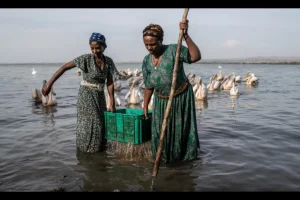
BY MENGESHA AMARE
In developing countries such as Ethiopia where the majority of the population is engaged in livelihoods largely dependent on the natural resource such as agriculture, factors like quality, availability and access to natural resources occupy a crucial role in influencing households’ income. In a situation like this, watershed development and management practices play a dual role of natural resource conservation as well as livelihood enhancement.
The Ethiopian Herald had a stay with Mohammed Abdu, an agro economist working for an international organization favoring agriculture. He said, “A watershed is a drainage area on earth’s surface from which runoff resulting from rainfall flowing from a single point to a large stream, river, lake or ocean.” Not only is the watershed simply a hydrological unit but it is also socio-political-ecological entity which plays a crucial role in determining food, social as well as economical security and provides life support services to rural and semi-urban citizenry.
Watershed development refers to the conservation, regeneration and judicious use of all natural resources particularly land, water, vegetation and development of fauna and flora under the circumference of the watershed, he added. As to him, watershed management is as old as the concept of crops under irrigated conditions. This concept led to development of reservoirs for increasing the production to meet the demand of ever growing population in various countries since ages. According to Mohammed, the need to maintain better environment and preserve natural resources such as soil, water and vegetation was realized by rulers and managed through different kinds of village institutions like local officials. The history of watershed management can be traced back to the eighteenth century.
For instance, improved soil quality and water availability facilitate higher crop productivity and more fodder for livestock, which in turn augments income earned by the people engaged in such a lucrative occupation. As to Mohammed, watershed development approach is based on participatory planning following a bottom-up approach for developing a context of proper execution. Hence, conservation and appropriate management of natural resources through holistic development of the watershed have to be well consolidated to help the country reap the benefit it deserves out of the scheme. He further said that operators or villagers create and maintain the assets and thus have a strong sense of ownership in the community-based participatory watershed development project, which is the key to the sustainability of such venture.
He said, “Watershed development programs aim to restore degraded watersheds in rain fed areas to increase the capacity to capture and store rainwater, reduce soil erosion, and improve soil nutrient and carbon content so they can produce greater agricultural yields and other benefits.” The primary cause for poverty and ostracism in rain fed rural areas is low crop and livestock productivity coupled with deterioration in the quality of land and other natural resources. Therefore, any attempt aimed at rural development and poverty alleviation has to address the issues related to conservation and management of natural resources and improving the productivity of land through different land management practices. This requires multidimensional, inter-sectorial and comprehensive efforts in an integrated approach, he added.

According to Mohammed, all land-based productive activities are dependent on the topography of the area, soil type, available biomass and water and call for adopting an integrated management approach, which can be better evolved within a natural domain such as the watershed. “As watershed is an intricate, dynamic and natural functional unit established by physical relationships and social communication and actions, it as a unit enables planners and implementing agency to systematically consider all inputs, processes and expected outputs which are essential for a holistic development approach,” Mohammed added.
He further elucidated that water availability in the future Ethiopia is predicted to be bleak if proper steps are not carried out to deal with the management of the available water resources. Apart from scarcity, problems related to poor quality of the available water resources may exacerbate the situation. Hence, possible solutions are expected to be devised to smash out the constraints on both the supply and demand side, and for both ground and surface water. He went on saying that ground water levels increased significantly in areas where water harvesting is effective in implementation. So additional employment generation has to considerably increase and social conservation works need to be made effective in a bid to come up with active employment of watershed development schemes.
“It is very important for the community to come together and participate in planning, initiation and execution of location-specific watersheds development activities such as soil, water and biomass conservation measures to make a given watershed project a success,” he underlined. Yes, he said public participation is the key to managing and sustaining the assets created under the watershed development project for community development.
Mohammed added that there is a close relationship between man and environment and any change in the environment directly affects the lives of the people depending on it for their sustenance. Therefore, it is utmost important to effectively tackle environmental degradation for the holistic development of the watershed with a view to addressing the issues of human development along with the capacity building of the stakeholders towards creation and maintenance of the assets which are important for ensuring the sustainability of a watershed development.
Scientifically, he further elaborated that watershed management involves management of land surface and vegetation so as to conserve and utilize water that falls on the watershed, and to conserve the soil for immediate and long term benefits to the rural farmers, community and society at large. “Watershed Development program is, therefore, considered as an effective tool for addressing many of these problems and recognized as potential engine for agriculture growth and development in fragile and marginal rain-fed areas,” Mohammed underscored.
Management of natural resources at watershed scale produces multiple benefits in terms of increasing food production, improving livelihoods, protecting environment, addressing gender and equity issues along with biodiversity concerns, he added. “A watershed—a drainage basin or catchment area—is defined as an area in which all water flowing into it goes to a common outlet. Generally, watershed is defined as a body of soil with definite boundaries around it, above it and below it. People and livestock and the integral part of watershed and their activities affect the productive status of watersheds and vice versa.”
More than half of the total arable land in Ethiopia is rain-fed, characterized by low productivity, low income, and low employment with high incidence of poverty and a bulk of fragile and marginal land. This trend has to be well reverted, he said.As to him, watershed management involves the effective use of all soil and water resources so as to provide a clean, uniform water supply for beneficial use and to control damage due to overflow. Employment generation, reduction of inequalities between irrigated and rain-fed areas and poverty alleviation, reduction of organic, inorganic and soil pollution, provision for adequate supply of water for domestic, industrial and agricultural entities need to be given due attention for better production, he opined.
Wrapping up his idea, Mohammed recommended that soil and water conservation practices are the primary step of watershed management program. Construction of squared dams, farm pond, gully control structures, pits excavation across the stream channel are badly needed and well expanded so as to help farmers across the nation come up with food security using all possible and seemly means of buttressing production and productivity.
THE ETHIOPIAN HERALD WEDNESDAY 15 MARCH 2023




